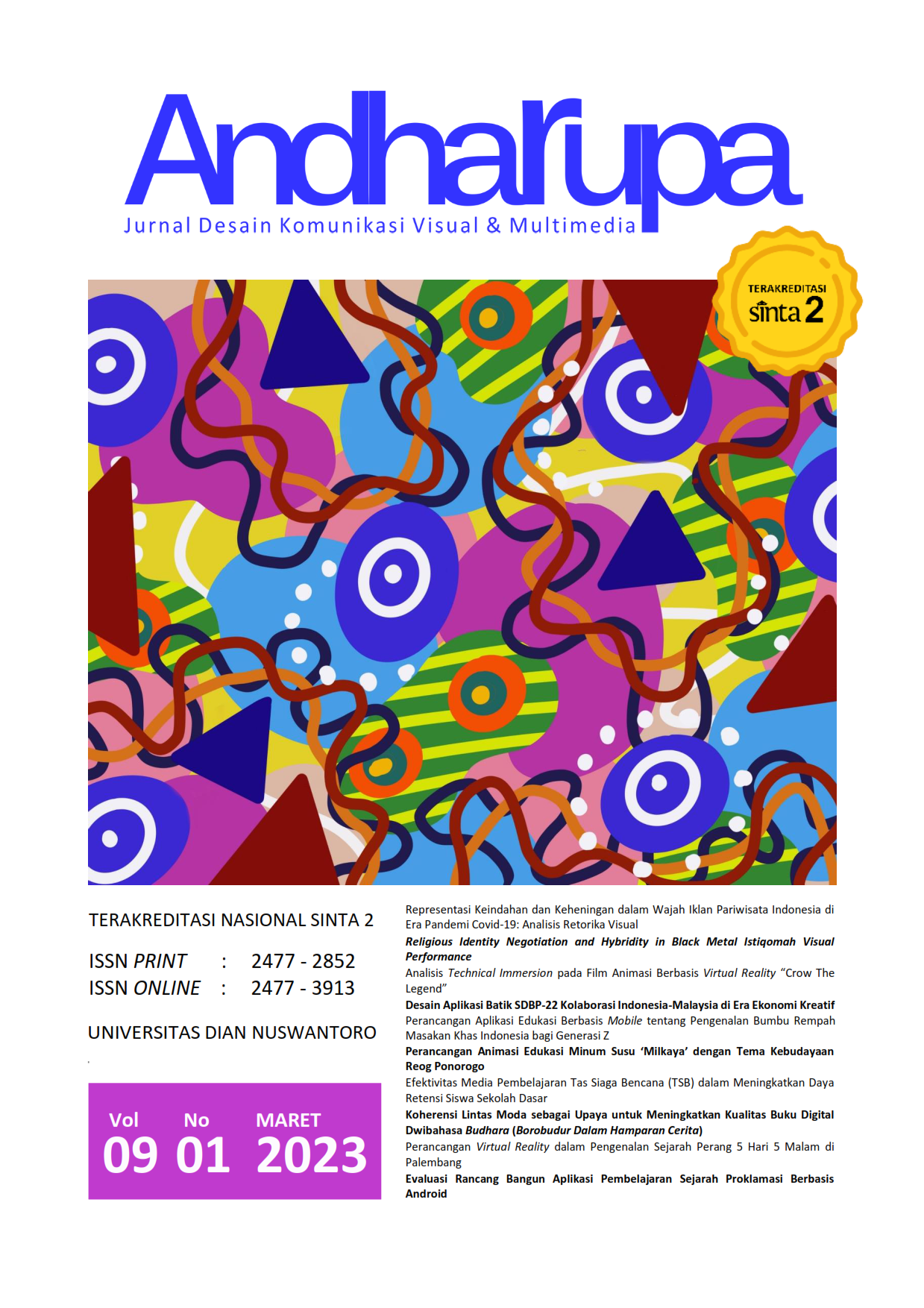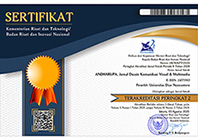Religious Identity Negotiation and Hybridity in Black Metal Istiqomah Visual Performance
DOI:
https://doi.org/10.33633/andharupa.v9i01.7057Abstract
AbstrakPenelitian ini membahas tentang identitas dan representasi bahasa visual Black Metal Istiqomah dalam melihat negosiasi yang terjadi di dalamnya. Lebih lanjut, negosiasi yang dimaksud antara identitas keagamaan dan hibriditas dalam performativitas visualitas dari Black Metal Istiqomah. Pengamatan dan penelusuran dilakukan dengan mengidentifikasi zine Black Metal Istiqomah di akun Instagram @blackmetalistiqomah melalui tiga karya komik strip berjudul “Komik Gelap”, “HP Menurutku, Menurutmu”, dan “Absolution”. Analisis negosiasi black metal dan Islam yang mengkonstruksi identitas akan dibedah melalui tanda verbal dan visual pada elemen visual dengan pendekatan semiotik oleh Roland Barthes, dan untuk melihat fenomena sosial ini digunakan teori performatif dari konsep hibriditas Richard Schechner terkait dengan Zine Black Metal Istiqomah. Black Metal Istiqomah sejak awal merupakan wujud identitas yang melekat pada karyanya. Ekspansinya menjadi brand fashion dan merchandise menjadi penanda identitas yang awalnya terkonstruksi dalam zine Black Metal Istiqomah, yang mulai diterima sebagai bentuk representasi diri bagi para penggemar yang memiliki cita-cita yang sama dengan Black Metal Istiqomah. Kata Kunci: Black Metal Istiqomah, hibriditas, negosiasi identitas keagamaan, performativitas visual Abstract This study discusses the identity and visual language representation of Black Metal Istiqomah in seeing the negotiations that occur in it. Furthermore, the intended negotiation between religious identity and hybridity in the visual performativity of Black Metal Istiqomah. Observations and searches were carried out by identifying the Black Metal Istiqomah zine on the @blackmetalistiqomah Instagram account through three comic strip work entitled "Komik Gelap", "HP According to You, and "Absolution". Analysis began with the negotiation of black metal and Islam that constructs identity. It will be dissected through verbal and visual signs on visual elements with a semiotic approach by Roland Barthes, and to see this social phenomenon using performative theory from Richard Schechner's concept of hybridity related to the Black Metal Istiqomah zine. Black Metal Istiqomah, from the beginning, is a form of identity attached to his work. Its expansion into a fashion brand and merchandise has become an identity marker initially constructed in the Black Metal Istiqomah zine, which began to be accepted as a form of self-representation for fans with the same ideals as Black Metal Istiqomah. Keywords: Black Metal Istiqomah, hybridity, religious identity negotiation, visual performativityReferences
Adams, K. M. (2006). Art as Politics: Re-Crafting Identities, Tourism, and Power in Tana Toraja, Indonesia. University of Hawai’i Press.
Agyeiwaah, E., Suntikul, W., & Carmen, L. Y. S. (2019). ‘Cool Japan’: Anime, soft power and Hong Kong generation Y travel to Japan. Journal of China Tourism Research, 15(2), 127–148.
Airriess, C., Hawkins, M., & Vaughan, E. (2012). Situating banal nationalism, the culture wars, and civil religion: governing localized geographies of national identity in Indiana. Social & Cultural Geography, 13(1), 49–67.
Akbulut, D., & Kesdi, H. (2017). On Context, Concepts and Research: An Approach in Basic Design. The Design Journal, 20(sup1), S1197–S1211.
Baluja, S. (2021). Immediate gestalt: shapes, typography and (quite irregular) shape packing. Journal of Mathematics and the Arts, 15(1), 54–75.
Barthes, R., & Howard, R. (1988). The Semiotic Challenge. Hill and Wang. https://books.google.co.id/books?id=G7adQgAACAAJ
Barthes, R., Lavers, A., & Smith, C. (1977). Elements of Semiology. Farrar, Straus and Giroux. https://books.google.co.id/books?id=OVJhOA6iWxEC
Boyce-Tillman, J. (2020). Re-enchanting the world: Music and spirituality. Journal for the Study of Spirituality, 10(1), 29–41.
Coebel, B. A. (2009). Comic Relief: Engaging Students through Humor Writing. The English Journal, 98(6), 38–43.
Coggins, O. (2021). Ecology, Estrangement and Enchantment in Black Metal’s Dark Haven. Green Letters, 25(2), 130–142.
Cotti-Lowell, A. F. (2013). Narrating through Comics in Patrick McCabe’s “The Butcher Boy.” New Hibernia Review / Iris Éireannach Nua, 17(4), 93–109.
Elliot, A. J. (2015). Color and psychological functioning: a review of theoretical and empirical work. Frontiers in Psychology, 6, 368.
Ferriss-Hill, J. L. (2019). Roman Satire and the Old Comic Tradition. Cambridge University Press.
Gao, Q., Woods, O., Kong, L., & Shee, S. Y. (2022). Lived religion in a digital age: technology, affect and the pervasive space-times of ‘new’ religious praxis. Social & Cultural Geography, 1–20.
Gomez-palacio, B., & Vit, A. (2009). Graphic Design Referenced: A Visual Guide to the Language, Applications, and History of Graphic Design. Rockport Publishers, Inc.
Grant, R. (2018). Using multiple religious belonging to test analogies for religion. International Journal of Philosophy and Theology, 79(4), 370–382.
Howell, J. D. (2001). Sufism and the Indonesian Islamic Revival. The Journal of Asian Studies, 60(3), 701–729.
Indrajaya, F. (2018). Art as the Manifestation of Embodiment in the Age of Modern technology. International Journal of Creative and Arts Studies, 5(1), 1–12.
Kia, C. (2012). Sufi orthopraxis: visual language and verbal imagery in medieval Afghanistan. Word & Image, 28(1), 1–18.
Konstantakos, I. M. (2015). Machon’s Alexandrian Comedy and Earlier Comic Tradition. Aevum, Anno 89(1), 13–36.
Kraszewski, J. (2011). Hybridity, History, and the Identity of the Television Studies Teacher. Cinema Journal, 50(4), 166–172.
Lang Hearlson, C. (2021). Converting the Imagination through Visual Images in Ecological Religious Education. Religious Education, 116(2), 129–141.
Lazard, A., & Mackert, M. (2014). User evaluations of design complexity: The impact of visual perceptions for effective online health communication. International Journal of Medical Informatics, 83(10), 726–735.
Leavy, P. (2017). Research Design: Quantitative, Qualitative, Mixed Methods, Arts-Based, and Community-Based Participatory Research Approaches. The Guilford Press.
Locke, K. (2015). Performativity, Performance and Education. Educational Philosophy and Theory, 47(3), 247–259.
Lundström, H. (2018). Music Among Ethnic Minorities in Southeast Asia. In R. Bader (Ed.), Springer Handbook of Systematic Musicology (pp. 987–1004). Springer Berlin Heidelberg.
Lusty, H. (2019). The State of Heavy Metal: A Review of Three Studies. Rock Music Studies, 6(3), 276–283.
Maidment, B. (2018). Caricature and the Comic Image in the 1830s. The Yearbook of English Studies, 48(Writing in the Age of William IV), 54–81.
Morris, M. (2015). Extreme Heavy Metal Music and Critical Theory. The Germanic Review: Literature, Culture, Theory, 90(4), 285–303.
Nasrullah, R., & Rustandi, D. (2016). Meme dan Islam : Simulakra Bahasa Agama di Media Sosial. Ilmu Dakwah: Academic Journal for Homiletic Studies, 10(1), 113–128.
Pacholczyk, J. M. (2018). Music and Islam in Indonesia. The World of Music, 28(3), 3–12.
Poyntz, S. R. (2006). Independent Media, Youth Agency, and the Promise of Media Education. Canadian Journal of Education, 29(1), 154–175.
Rico, T. (2019). Islam, Heritage, and Preservation: An Untidy Tradition. Material Religion, 15(2), 148–163.
Robinson, R., & Cussen, F. (2022). The Spirituality of Language in Cecilia Vicuña’s and Ana María Uribe’s Visual Poetry. Bulletin of Spanish Studies, 1–22.
Salazar, N. B. (2013). Imagineering Otherness: Anthropological Legacies in Contemporary Tourism. Anthropological Quarterly, 86(3), 669–696.
Sampurno, M. B. T., Kusumandyoko, T. C., & Islam, M. A. (2020). Budaya Media Sosial, Edukasi Masyarakat, dan Pandemi COVID-19. SALAM: Jurnal Sosial Dan Budaya Syar-I, 7(5).
Schechner, R. (2013). Performance Studies: An Introduction. Routledge.
Schechner, R. (2018). Performed Imaginaries. Routledge.
Schlund-Vials, C. J. (2011). Crisis of Memory: Memorializing 9/11 in the Comic Book Universe. Modern Language Studies, 41(1), 12–25.
Tashakkori, A., & Creswell, J. (2008). Mixed Methodology Across Disciplines. Journal Of Mixed Methods Research, 2(1), 1–5.
van Leeuwen, T., & Djonov, E. (2015). Notes towards a semiotics of kinetic typography. Social Semiotics, 25(2), 244–253.
Wiratmoko, C., & Sampurno, M. B. T. (2021). The Enchantment of Tiktok as Gen Z Creativity Place in SMA Negeri 2 Surabaya’s Batik Motifs Online Exhibition. Education and Human Development Journal, 6(2 SE-Articles), 1–11.
Yamato, E. (2016). ‘Growing as a person’: experiences at anime, comics, and games fan events in Malaysia. Journal of Youth Studies, 19(6), 743–759.
Y?ld?r?m, M. (2020). Individual, organization and structure: Rethinking social construction of everyday life at workplace in tourism industry. Tourism Management, 76(August 2019), 103965.
Zhu, X., Sun, B., & Luo, Y. (2018). Interactive learning system “VisMis” for scientific visualization course. Interactive Learning Environments, 26(4), 553–565.
Downloads
Published
Issue
Section
License
Authors who publish with this journal agree to the following terms:
- Authors retain copyright and grant the journal right of first publication with the work simultaneously licensed under a Creative Commons Attribution License that allows others to share the work with an acknowledgment of the work's authorship and initial publication in this journal.
- Authors are able to enter into separate, additional contractual arrangements for the non-exclusive distribution of the journal's published version of the work (e.g., post it to an institutional repository or publish it in a book), with an acknowledgment of its initial publication in this journal.
- Authors are permitted and encouraged to post their work online (e.g., in institutional repositories or on their website) prior to and during the submission process, as it can lead to productive exchanges, as well as earlier and greater citation of published work (See The Effect of Open Access).















